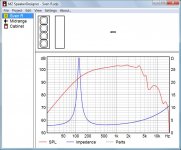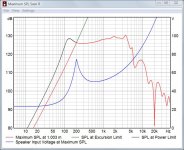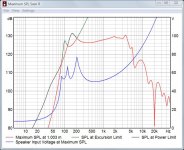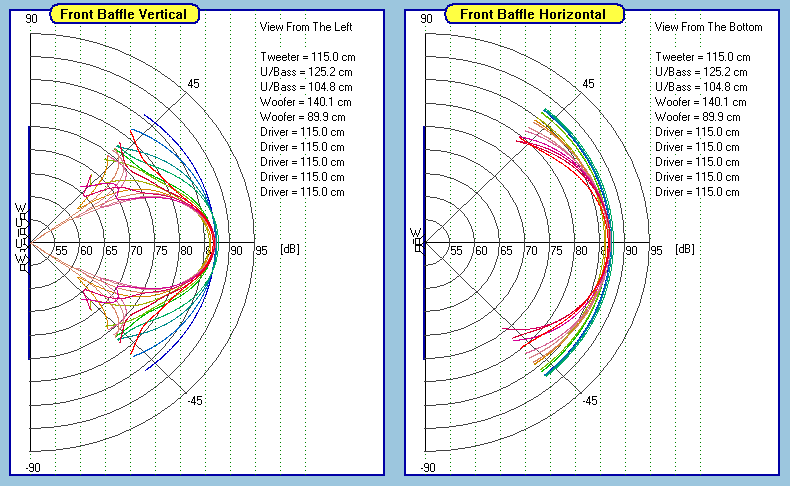ASSISTANCE WITH SOFTWARE/DESIGN?
Greetings,
I am an Electrical Engineer in the domain of Electroacoustics, American now residing in Bosnia. I know a local dealer of '18 Sound' and have asked him to get me 8 cones for this small project. Namely, I wish to make a small P. A. System for a local club, and my intention is to use '18 Sound' 6,5 inch model 6ND430 cones for midrange.
I need two small enclosures, consisting each of 4x 6ND430, using a total of 8 speakers. It is to be a simple ducted port enclosure, with 4 speakers mounted in a vertical array, tightly mounted next to each other. Enclosure is going to be approx. 70 cm tall and approx. 25 cm wide (need that width for 23x23 cm Beyma TPL 150-H H. F. horn on top of those 4 midrange speakers) and as deep as neccessary for a total appropriate Volume of the box (in liters – metric calculations preferred here).
I now do not have anything better than a rather simple software, BassBox 6 Pro, which might give me good results to design this box (?), but I wander if anyone has better software with appropriate exeprience to use it, to suggest proper size, that is, internal volume and size od ducted ports (preferrence towards rectangular or triangular ports as opposed to round), for such an 4x 6ND430 enclosure?
Frequency range of my midrange box is to be 150 to 1,5k Hz, crossed over at 150 or 160 Hz (-6 dB at X-over frequency with 24db/Octave L-R passive X-over) high-pass, and 1k or 1,2k Hz, low-pass. Mounting of cones is to be from the outside of the enclosure.
Club size calls for a 16 meters throw (approx. -24dB), which means that a peak of 125 dB SPL should be OK. Sensitivity of this enclosure, according to my calculations, is approx. 100 dB (1W @ 1m) and could easily reach 125dB without distortion (300 W input, of course), which approximately mateches a max. of H. F. Unit's 124 dB (at 160 W).
Speakers need to be 16 Ohm each, to be used in parallel for a total of 4 Ohm for the enclosure.
Would you advise? Could you run your own calculations and recommend the best solution? Thanks.
Sincerely,
Sven
Greetings,
I am an Electrical Engineer in the domain of Electroacoustics, American now residing in Bosnia. I know a local dealer of '18 Sound' and have asked him to get me 8 cones for this small project. Namely, I wish to make a small P. A. System for a local club, and my intention is to use '18 Sound' 6,5 inch model 6ND430 cones for midrange.
I need two small enclosures, consisting each of 4x 6ND430, using a total of 8 speakers. It is to be a simple ducted port enclosure, with 4 speakers mounted in a vertical array, tightly mounted next to each other. Enclosure is going to be approx. 70 cm tall and approx. 25 cm wide (need that width for 23x23 cm Beyma TPL 150-H H. F. horn on top of those 4 midrange speakers) and as deep as neccessary for a total appropriate Volume of the box (in liters – metric calculations preferred here).
I now do not have anything better than a rather simple software, BassBox 6 Pro, which might give me good results to design this box (?), but I wander if anyone has better software with appropriate exeprience to use it, to suggest proper size, that is, internal volume and size od ducted ports (preferrence towards rectangular or triangular ports as opposed to round), for such an 4x 6ND430 enclosure?
Frequency range of my midrange box is to be 150 to 1,5k Hz, crossed over at 150 or 160 Hz (-6 dB at X-over frequency with 24db/Octave L-R passive X-over) high-pass, and 1k or 1,2k Hz, low-pass. Mounting of cones is to be from the outside of the enclosure.
Club size calls for a 16 meters throw (approx. -24dB), which means that a peak of 125 dB SPL should be OK. Sensitivity of this enclosure, according to my calculations, is approx. 100 dB (1W @ 1m) and could easily reach 125dB without distortion (300 W input, of course), which approximately mateches a max. of H. F. Unit's 124 dB (at 160 W).
Speakers need to be 16 Ohm each, to be used in parallel for a total of 4 Ohm for the enclosure.
Would you advise? Could you run your own calculations and recommend the best solution? Thanks.
Sincerely,
Sven
Yes, but -6dB pattern of the tweeter is around 80° through the relevant range, so the piston size of a larger driver matches better on the horizontal, and can give the SPL wanted at the same time. On the vertical, this isn't a real line array, so the minimum center-to-center from the bottom mid to the tweeter of 85cm is significant. Even if you went MMTMM for 43cm spacing, you'd probably end up with a null over part of the audience. Am I wrong?
Hi,
Zaph|Audio
16 ohm driver specs are here.
Look at the MMTMM here :
Zaph|Audio - ZA5 Speaker Designs with ZA14W08 woofer and Vifa DQ25SC16-04 tweeter
About 8L per driver tuned to 80Hz is one option.
Do a proper passive mid/treble x/o (including tweeter protection)
and then biamp with active x/o's for the bass to mid crossover.
rgds, sreten.
Zaph|Audio
16 ohm driver specs are here.
Look at the MMTMM here :
Zaph|Audio - ZA5 Speaker Designs with ZA14W08 woofer and Vifa DQ25SC16-04 tweeter
About 8L per driver tuned to 80Hz is one option.
Do a proper passive mid/treble x/o (including tweeter protection)
and then biamp with active x/o's for the bass to mid crossover.
rgds, sreten.
Last edited:
Hi Sven,
I made a simulation of your speaker. A closed box of 23 litres without crossover:

The SPL at 2.83 volt/1m is more than 100 dB, but the impedance is only 3 ohm.
The maximum SPL is above 125 dB, but the power is 800 watt:

Below 200 Hz the SPL is restricted by the maximum linear excursion limit. A vented design can boost the range around the tuning frequency, but it is worse at lower frequencies:

The drivers only need a volume around 5 litres each, and the vent is 128 mm diameter and 75 mm length. I'm not familiar with high power PA and wonder what happens, if you feed 800 watt into such a small 20 litres box. Probably you need much more vents for cooling purpose!
I made a simulation of your speaker. A closed box of 23 litres without crossover:

The SPL at 2.83 volt/1m is more than 100 dB, but the impedance is only 3 ohm.
The maximum SPL is above 125 dB, but the power is 800 watt:

Below 200 Hz the SPL is restricted by the maximum linear excursion limit. A vented design can boost the range around the tuning frequency, but it is worse at lower frequencies:

The drivers only need a volume around 5 litres each, and the vent is 128 mm diameter and 75 mm length. I'm not familiar with high power PA and wonder what happens, if you feed 800 watt into such a small 20 litres box. Probably you need much more vents for cooling purpose!
Last edited:
If you're only going to take them down to 150HZ, I'd use a closed box design for better and more consistent (over frequency) physical damping. Ports can become un-tuned over time, as the drivers age. I'd also see if they wouldn't work fine down to 100HZ since the male talking voice is usually around 110HZ according to my own tests.
Using a vertical line array is a great idea. It's acoustic output drops off more slowly as you distance yourself from the cabinet, and the vertical off axis response will roll off significantly faster than with a single driver, which means significantly less floor and ceiling bounce, which often causes severe (10dB) comb filter notches all across the spectrum in a typical listening room.
I would hesitate to go much above 1kHZ for the upper crossover point, since the horizontal off axis response will roll off in a way that won't integrate well with the tweeter, which will probably have much wider dispersion when it comes in around 1.5kHZ due to it's small physical size. Any abrupt frequency response anomoly between about 800HZ and about 6kHZ is particularly difficult to listen to since that's where our ears are most sensitive (see Fletcher-Munson curves).
Using a vertical line array is a great idea. It's acoustic output drops off more slowly as you distance yourself from the cabinet, and the vertical off axis response will roll off significantly faster than with a single driver, which means significantly less floor and ceiling bounce, which often causes severe (10dB) comb filter notches all across the spectrum in a typical listening room.
I would hesitate to go much above 1kHZ for the upper crossover point, since the horizontal off axis response will roll off in a way that won't integrate well with the tweeter, which will probably have much wider dispersion when it comes in around 1.5kHZ due to it's small physical size. Any abrupt frequency response anomoly between about 800HZ and about 6kHZ is particularly difficult to listen to since that's where our ears are most sensitive (see Fletcher-Munson curves).
Greetings,
First, big thanks to all members who were kind to take interest in this small project - especially to members Sreten and Dissi, who made simulations.
Let me first give some answers and some thoughts - and pose some more questions (do we ever?):
1. I choose 6,5¨ cone which is basically a L.F. cone, accordng to '18 Sound' data (for example, Xmax is 5 mm, each way), and it can easily go down to my high-pass X-over frequency of 150 or 160 Hz, which also happens to be my recommendation for most bass-mid bass/low mids, X-over point (I also like the P. A. to have a -6 dB at that center frequency - works very good in most rooms).
2. Also, 6,5¨ is a very small cone, which means that it is supposed to have much better transient response than a 12¨ one, due to laws of Physics (lower Mms, mass of the moving parts and such).
3. Furthermore, 4 cones in a vertical array, tightly mounted, give less lobing problems below 1k Hz (also Physics/Acoustics) than a single cone of any size, including 12¨ size that member 'dumptruck' recommended (and most people would use). Also, comments of one of the gentlemen, Bob Richards, explain my point of improving vertical control very well indeed (especially since this club has a low ceiling, approx. 3 to 4 meters, max.).
4. My simulation with BassBox 6 Pro, with 12dB/Octave simulated filter at 73Hz makes less demands for low frequency response, which matches real situation of my using passive X-over at 150Hz, and calls for 16,6 liter enclosure and two vents of 42 mm diameter and 80 mm length, each. This is just to give you an idea of my starting point, which is perhaps not good enough, and which is why I asked for assistance.
5. MOST IMPORTANT QUESTION: I have used closed midrange enclosure a long time ago in one P.A. for clubs (when I was mixing sound for a rock band), but never seen a closed midrange enclosure since (all manufacturers use ported enclosures), so I would like some explanation as to ADVANTAGES (and disadvantages?) of a closed box vs. ported enclosure. Is the transient response, group delay, freq. response and such, of a closed box better (important for midrange) and are the problems of low-end (say 150-200 Hz) of such closed box going to appear, regarding Xmax of 5 mm at higher powers/higher SPL, up to 125 dB max. where I wish to make my peaks in this P. A. system?
All the best and thanks - especially to gents who were kind enough to make simulations! I am going to look at them now, but could not resist replying immediately in order to express my thanks. ¨Talk to you¨ soon.
Sven
First, big thanks to all members who were kind to take interest in this small project - especially to members Sreten and Dissi, who made simulations.
Let me first give some answers and some thoughts - and pose some more questions (do we ever?):
1. I choose 6,5¨ cone which is basically a L.F. cone, accordng to '18 Sound' data (for example, Xmax is 5 mm, each way), and it can easily go down to my high-pass X-over frequency of 150 or 160 Hz, which also happens to be my recommendation for most bass-mid bass/low mids, X-over point (I also like the P. A. to have a -6 dB at that center frequency - works very good in most rooms).
2. Also, 6,5¨ is a very small cone, which means that it is supposed to have much better transient response than a 12¨ one, due to laws of Physics (lower Mms, mass of the moving parts and such).
3. Furthermore, 4 cones in a vertical array, tightly mounted, give less lobing problems below 1k Hz (also Physics/Acoustics) than a single cone of any size, including 12¨ size that member 'dumptruck' recommended (and most people would use). Also, comments of one of the gentlemen, Bob Richards, explain my point of improving vertical control very well indeed (especially since this club has a low ceiling, approx. 3 to 4 meters, max.).
4. My simulation with BassBox 6 Pro, with 12dB/Octave simulated filter at 73Hz makes less demands for low frequency response, which matches real situation of my using passive X-over at 150Hz, and calls for 16,6 liter enclosure and two vents of 42 mm diameter and 80 mm length, each. This is just to give you an idea of my starting point, which is perhaps not good enough, and which is why I asked for assistance.
5. MOST IMPORTANT QUESTION: I have used closed midrange enclosure a long time ago in one P.A. for clubs (when I was mixing sound for a rock band), but never seen a closed midrange enclosure since (all manufacturers use ported enclosures), so I would like some explanation as to ADVANTAGES (and disadvantages?) of a closed box vs. ported enclosure. Is the transient response, group delay, freq. response and such, of a closed box better (important for midrange) and are the problems of low-end (say 150-200 Hz) of such closed box going to appear, regarding Xmax of 5 mm at higher powers/higher SPL, up to 125 dB max. where I wish to make my peaks in this P. A. system?
All the best and thanks - especially to gents who were kind enough to make simulations! I am going to look at them now, but could not resist replying immediately in order to express my thanks. ¨Talk to you¨ soon.
Sven
I don't mean to be argumentative, but how do you figure that? A 12" would only have a null at the crossover point, and that null would be a bit outside your tweeter pattern in this case. Four stacked 6.5" will have nulls before you even bring in the HF. Zaph's design linked to above has significant vertical nulls (see his measurement below), and his is basically and MTM with 0.5 woofers on the outside. All the woofers playing the same range stacked below the HF would have much more severe variation. Dissi could show some of this by moving the mic in that sim, although adding the HF and crossover is when it will really go bonkers.3. Furthermore, 4 cones in a vertical array, tightly mounted, give less lobing problems below 1k Hz (also Physics/Acoustics) than a single cone of any size, including 12¨ size that member 'dumptruck' recommended (and most people would use). Also, comments of one of the gentlemen, Bob Richards, explain my point of improving vertical control very well indeed (especially since this club has a low ceiling, approx. 3 to 4 meters, max.).

Bob's guess about the tweeter dispersion is wrong - it's more like a large woofer as I said earlier. This is also not going to act like a real line array.
Last edited:
If the tweeter has a horn that acts as a waveguide, then dumptruck is right. I didn't look at the spec for the tweeter before mouthing off.Bob's guess about the tweeter dispersion is wrong - it's more like a large woofer as I said earlier. This is also not going to act like a real line array.
On the nulls, they will exist, but I'm skeptical as to whether they will be a significant issue. In the lower midrange the wavelengths are getting long, so less of a problem, and when the tweeter gets crossed in around 1.5kHZ you'll be back to a single sound source, so no nulls due to that. I would expect that room acoustics are likely to give you much worse nulls at most if not all listening positions. I think QSC makes a sound column much like the one you are building. A band we like to go see here in Portland uses them. They sound real good.
- Status
- This old topic is closed. If you want to reopen this topic, contact a moderator using the "Report Post" button.
- Home
- Loudspeakers
- Multi-Way
- 4x6,5¨ midrange ported enclosure assistance?